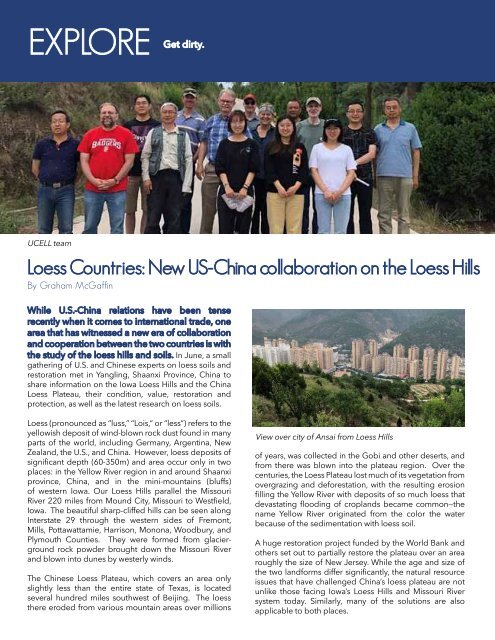Siouxland Magazine - Volume 2 Issue 2
You also want an ePaper? Increase the reach of your titles
YUMPU automatically turns print PDFs into web optimized ePapers that Google loves.
explore<br />
Get dirty.<br />
UCELL team<br />
Loess Countries: New US-China collaboration on the Loess Hills<br />
By Graham McGaffin<br />
While U.S.-China relations have been tense<br />
recently when it comes to international trade, one<br />
area that has witnessed a new era of collaboration<br />
and cooperation between the two countries is with<br />
the study of the loess hills and soils. In June, a small<br />
gathering of U.S. and Chinese experts on loess soils and<br />
restoration met in Yangling, Shaanxi Province, China to<br />
share information on the Iowa Loess Hills and the China<br />
Loess Plateau, their condition, value, restoration and<br />
protection, as well as the latest research on loess soils.<br />
Loess (pronounced as “luss,” “Lois,“ or “less”) refers to the<br />
yellowish deposit of wind-blown rock dust found in many<br />
parts of the world, including Germany, Argentina, New<br />
Zealand, the U.S., and China. However, loess deposits of<br />
significant depth (60-350m) and area occur only in two<br />
places: in the Yellow River region in and around Shaanxi<br />
province, China, and in the mini-mountains (bluffs)<br />
of western Iowa. Our Loess Hills parallel the Missouri<br />
River 220 miles from Mound City, Missouri to Westfield,<br />
Iowa. The beautiful sharp-cliffed hills can be seen along<br />
Interstate 29 through the western sides of Fremont,<br />
Mills, Pottawattamie, Harrison, Monona, Woodbury, and<br />
Plymouth Counties. They were formed from glacierground<br />
rock powder brought down the Missouri River<br />
and blown into dunes by westerly winds.<br />
The Chinese Loess Plateau, which covers an area only<br />
slightly less than the entire state of Texas, is located<br />
several hundred miles southwest of Beijing. The loess<br />
there eroded from various mountain areas over millions<br />
View over city of Ansai from Loess Hills<br />
of years, was collected in the Gobi and other deserts, and<br />
from there was blown into the plateau region. Over the<br />
centuries, the Loess Plateau lost much of its vegetation from<br />
overgrazing and deforestation, with the resulting erosion<br />
filling the Yellow River with deposits of so much loess that<br />
devastating flooding of croplands became common—the<br />
name Yellow River originated from the color the water<br />
because of the sedimentation with loess soil.<br />
A huge restoration project funded by the World Bank and<br />
others set out to partially restore the plateau over an area<br />
roughly the size of New Jersey. While the age and size of<br />
the two landforms differ significantly, the natural resource<br />
issues that have challenged China’s loess plateau are not<br />
unlike those facing Iowa’s Loess Hills and Missouri River<br />
system today. Similarly, many of the solutions are also<br />
applicable to both places.


















